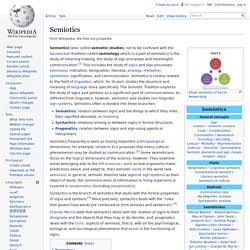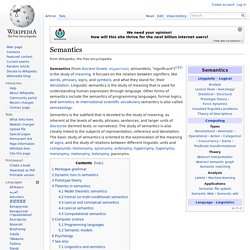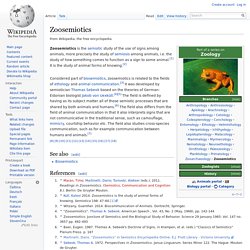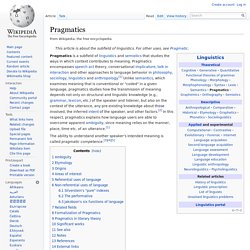

Symbol. A red octagon symbolizes "stop" even without the word.

A symbol is an object that represents, stands for, or suggests an idea, visual image, belief, action, or material entity. Symbols take the form of words, sounds, gestures, or visual images and are used to convey ideas and beliefs. For example, a red octagon may be a symbol for "STOP". On a map, a picture of a tent might represent a campsite. Numerals are symbols for numbers. Etymology[edit] The word derives from the Greek symbolon meaning token or watchword. Sign. This biohazard sign is a completely conventional symbol with no inherent relationship to what it represents.

Semiotics for Beginners: Signs. Semiotics. Semiotics frequently is seen as having important anthropological dimensions; for example, Umberto Eco proposes that every cultural phenomenon may be studied as communication.[2] Some semioticians focus on the logical dimensions of the science, however.

They examine areas belonging also to the life sciences – such as how organisms make predictions about, and adapt to, their semiotic niche in the world (see semiosis). In general, semiotic theories take signs or sign systems as their object of study: the communication of information in living organisms is covered in biosemiotics (including zoosemiotics).
Syntactics is the branch of semiotics that deals with the formal properties of signs and symbols.[3] More precisely, syntactics deals with the "rules that govern how words are combined to form phrases and sentences".[4] Biosemiotics. Semiosis. Introduction to theory[edit] Discussion[edit] Semiosis is the performance element involving signs.

Although a human can communicate many things unintentionally, individuals usually speak or write to elicit some kind of response. Yet there is little real explanation of how semiosis produces its effects, which is odd given that the word "sign" is in everyday use and most people would understand what it means. But semiotics has not offered clear technical definitions, nor is there agreement about how signs should be classified. In biology, scout bees and ants will return home to tell the others where food is to be found, the fact of fertility must be announced to prospective mates from the same species, and the presence of danger must be passed as a warning to others in the group.
Semantics. Montague grammar[edit] In the late 1960s, Richard Montague proposed a system for defining semantic entries in the lexicon in terms of the lambda calculus.

In these terms, the syntactic parse of the sentence John ate every bagel would consist of a subject (John) and a predicate (ate every bagel); Montague demonstrated that the meaning of the sentence altogether could be decomposed into the meanings of its parts and in relatively few rules of combination. The logical predicate thus obtained would be elaborated further, e.g. using truth theory models, which ultimately relate meanings to a set of Tarskiian universals, which may lie outside the logic.
The notion of such meaning atoms or primitives is basic to the language of thought hypothesis from the 1970s. Despite its elegance, Montague grammar was limited by the context-dependent variability in word sense, and led to several attempts at incorporating context, such as: Dynamic turn in semantics[edit] Prototype theory[edit] Zoosemiotics. Zoosemiotics is the semiotic study of the use of signs among animals, more precisely the study of semiosis among animals, i.e. the study of how something comes to function as a sign to some animal.[1] It is the study of animal forms of knowing.[2] Considered part of biosemiotics, zoosemiotics is related to the fields of ethology and animal communication.[3] It was developed by semiotician Thomas Sebeok based on the theories of German-Estonian biologist Jakob von Uexküll.[4][5] The field is defined by having as its subject matter all of those semiotic processes that are shared by both animals and humans.[6] The field also differs from the field of animal communication in that it also interprets signs that are not communicative in the traditional sense, such as camouflage, mimicry, courtship behavior etc.

The field also studies cross-species communication, such as for example communication between humans and animals.[7] See also[edit] Biosemiotics. Pragmatics. Pragmatics is a subfield of linguistics and semiotics that studies the ways in which context contributes to meaning.

Pragmatics encompasses speech act theory, conversational implicature, talk in interaction and other approaches to language behavior in philosophy, sociology, linguistics and anthropology.[1] Unlike semantics, which examines meaning that is conventional or "coded" in a given language, pragmatics studies how the transmission of meaning depends not only on structural and linguistic knowledge (e.g., grammar, lexicon, etc.) of the speaker and listener, but also on the context of the utterance, any pre-existing knowledge about those involved, the inferred intent of the speaker, and other factors.[2] In this respect, pragmatics explains how language users are able to overcome apparent ambiguity, since meaning relies on the manner, place, time etc. of an utterance.[1] The ability to understand another speaker's intended meaning is called pragmatic competence.[3][4][5] Example: "I"